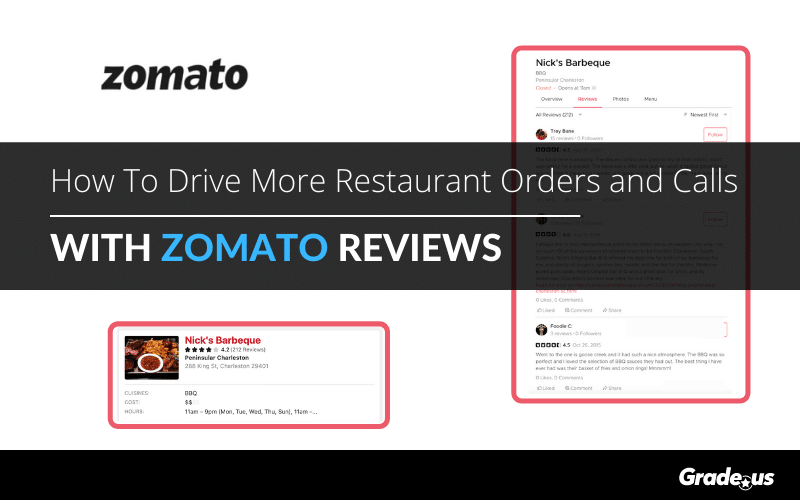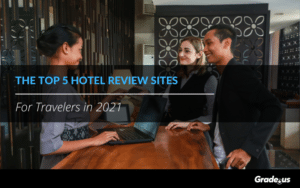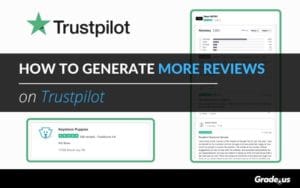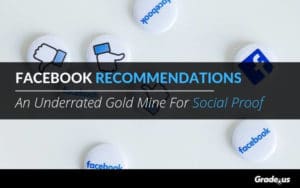When it comes to the restaurant industry, where do Zomato reviews appear in importance? Can restaurants use review management to boost their traffic with this essential review site?
Restaurant traffic is down.
And it’s continuing to fall. Research from Black Box Intelligence shows consumer foot traffic has been steadily declining for some time. The industry saw a decrease of -3.6%, which continued, year by year, to -3.53% in 2019.
Most restaurateurs feel this decline.
The question is why and what restaurateurs can do to reverse this trend in their business? We’ll show you how Zomato and other review platforms like it, can drive more foot traffic to your restaurant.
Here’s what we’ll cover today:
Table of Contents
Get more reviews on Zomato
Why Zomato is important to your restaurant
Zomato is a food aggregator that provides customers with restaurant menus, reviews, and information. They also provide food delivery options via partner restaurants in select cities. Their service is available in 24 countries and more than 10,000 cities. Their service is available in 10+ languages.
They’re an international company.
Originally founded in India, Zomato is growing rapidly. Their acquisition of Urbanspoon marked their entry into the U.S., Canada, and Australia competing directly with other review platforms like Zomato and Foursquare.
Why does this matter?
Zomato is growing quietly, working to displace established platforms like Yelp as the dominant platform for restaurants and foodservice.
- 2019 revenue is listed at $206 million
- 16 million reviews and photos received in March 2019 alone
- 100 million+ monthly visits to Zomato properties
- 1.4 million restaurants listed
- 12,000 restaurants advertise on Zomato
- Zomato provides restaurateurs an 8x return for every dollar spent
- Their platform receives 3 million+ orders per month
Did you catch it?
The reason why Zomato is so important to your business?
There are 1.4 million restaurants listed on Zomato, but only a small fraction of those restaurants (12K) advertise on the platform. That’s surprising when contrasted with the 8x returns Zomato claims to provide. You’d think restaurants would be willing to test that claim for themselves.
Think about that for a second.
Restaurants receive $24 for every $3 invested when they advertise on Zomato. That’s a sizeable return on investment, especially if these claims are true. So why aren’t more restaurants testing this for themselves?
They don’t know about it.
They aren’t aware of the value Zomato’s platform provides, and they don’t know much about their users. In fact, many consumers aren’t familiar with Zomato’s brand, yet.
Who visits Zomato?
Zomato doesn’t share the specifics of their user demographics. That said, they’re focused on a specific demographic.
They’re focused on Foodies.
Foodies are defined as:
“A foodie is a person who has an ardent or refined interest in food and who eats food not only out of hunger but due to their interest or hobby. The terms “gastronome” and “gourmet” define the same thing, i.e., a person who enjoys food for pleasure.”
According to the International Food Information Council Foundation, Foodies are:
- 37% male and 63% female
- Older, averaging 58 years
- 67% are married or in a committed relationship
- 15% have kids under 18 years of age
These sophisticated users are focused on for parameters Zomato calls the QAAA — Quality, Accessibility, Affordability, and Assortment.
“Across the world, restaurants are competing with, and gaining share from home-cooking. Their ability to do so depends on four parameters. Anywhere in the world, when the restaurant industry improves its score on these four parameters, there is a shift in user behavior, away from the kitchen in their homes, towards restaurants.”
Zomato is actually in the business of creating foodies. They believe a focus on their QAAA parameters creates a shift away from home cooking. This is their goal. Creating, influencing, and changing Foodie behavior.
How Zomato compares to other review platforms
Zomato started as a niche provider but they’re quickly becoming a mainstream platform as their service continues to mature. Restaurants are in a great position — they have the chance to build a large following on Zomato before their platform is fully mainstream.
Here’s how their platform compares with the big three.
Zomato is primed for growth.
Their acquisition of Urbanspoon gave them the opening they needed to enter the North American market. But consumers aren’t as familiar with the brand as they should be.
This is changing rapidly.
But this also means your restaurant’s goals should be slightly different on Zomato than it is on other platforms.
What your goals should be on Zomato
Zomato has a variety of tools, resources, and programs brands can use to achieve broad business goals.
- Clicks: The number of people who click through from your Zomato profile to your website. If you're looking to drive online conversions with these online visits, you'll need to ensure you maintain ad sent from your profile to your landing page.
- Referrals: Aka leads, are available via a variety of free and paid channels. These leads aren't simply focused on customer contact info; it's the contact info from engaged and motivated customers who are looking for a specific experience from your restaurant.
- Reviews: This is the main conversion driver on Zomato. Customers are looking for specific information from customers regarding all aspects of their experience — taste, quality, service, and pricing.
- Online orders: Direct orders placed via their platform from participating restaurants in select cities. This is dependent on other factors like availability and pricing.
- Bookmarks: A feature available to users enabling them to bookmark their favorite places or save a business for later. According to Zomato, this is a good sign as it shows your lead volume is growing. Zomato also includes an analogous "Add to collection" feature. You can increase bookmarks using their information badge widget.
As a platform, Zomato is more focused.
Things are more simplified on Zomato than a mainstream platform like Yelp. Users receive specific information from the restaurants on their site.
- General information: This includes phone numbers, cuisine type, website, hours of operation, address (with directions), and additional info.
- Menu: Specific information that provides users with the information they need to place an order, make a reservation or stop in for an impromptu visit.
- Photos: These are both brand and user photos. There's no limit to the number of photos that can be posted on your profile, so it's a good idea to direct the narrative by adding your own.
- Reviews: This is the secret sauce that drives conversion. Here's what makes Zomato reviews so different from other platforms. Users can like and comment on other customer's reviews. Users can also follow reviewers on Zomato. This is a two-edged sword that works for or against restaurants.
Here’s how you build a powerful presence on Zomato.
Claiming or creating your profile on Zomato
Claiming/creating your profile is the easy part. Here’s how you do it.
1. Visit Zomato.com/business.
2. Enter your city and the name of your business in the search field.
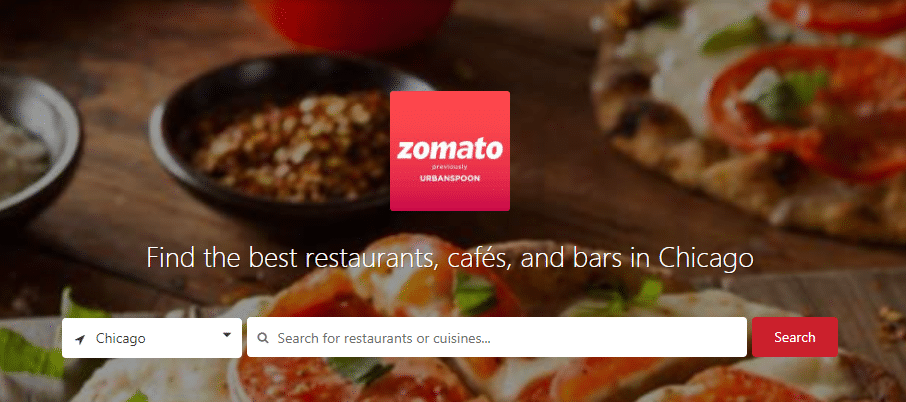
3. If you can’t find your business, click the “Add a Restaurant” button to create a listing.

4. Enter general information for your restaurant (e.g., name, city, phone number, etc.)
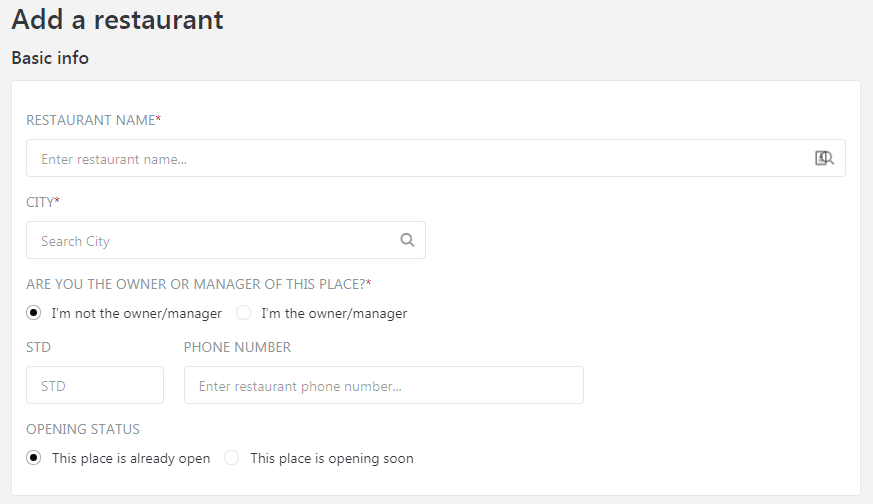
5. Enter the address and location details for your restaurant.
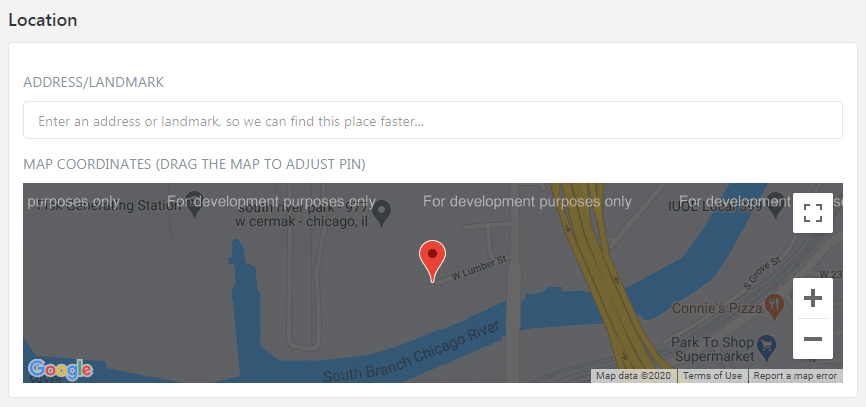
6. Add the “characteristics” information for your business (e.g., alcohol, services, seating, payment, cuisines, tags, etc.)
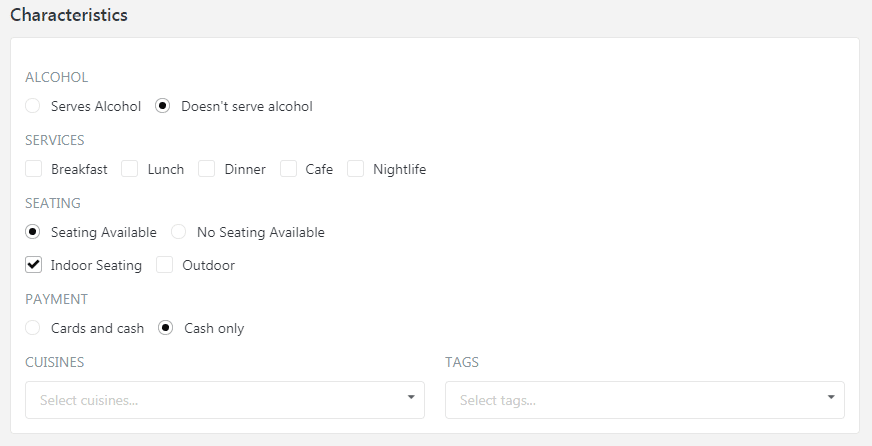
7. Add your “Timings” (days/hours of operation).
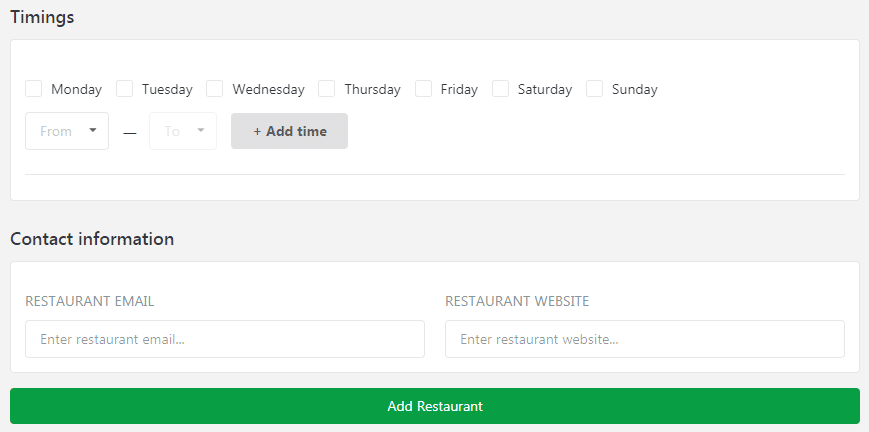
8. Finally, add the contact email for your restaurant and your restaurant’s website.
What happens next?
Verification.
“Once you send the information to us, our awesome content team will verify it. To help speed up the process, please provide a contact number or email address… Once verified, the listing will start appearing on Zomato.”
Notice the strange wording on Zomato’s website? It’s not just you, that’s a byproduct of their rapid expansion. Their organization was originally founded in India so the wording is a bit… off for our tastes. This is good news — slowly but surely, they’re working out the kinks.
This is why it’s so important to optimize your Zomato profile now before they’re a mainstream provider.
Optimizing your Zomato profile
Optimizing your profile is a straightforward process; Zomato doesn’t require as much information as other platforms, so they’re easier to work with. You can optimize your profile in one of two ways.
1. Take the time to enter all of the requested information in your Zomato profile. Tell the whole story by completing each section and adding important details.
2. When customers come in incentivize sharing via an irresistible offer (i.e., a bonus, discount, free offer, timed offer or giveaway). Give them a reason to share their phone number or email address with you. Be sure to emphasize the fact that you’ll respect their privacy and wishes regarding the use of their contact details.
3. Make review reminders a habit (i.e., we’re on Zomato). The better your aggregate reviews, the easier it is to attract customers in your reviewer’s social circle or sphere of influence. This is especially important if you’re in a large or competitive area (i.e., Chicago).
Here’s an important takeaway.
With Zomato, local search and social dominance (via online reviews) play a pivotal role. Your profile is an important, secondary step. This will change as brand recognition grows rapidly in new markets (i.e., North America).
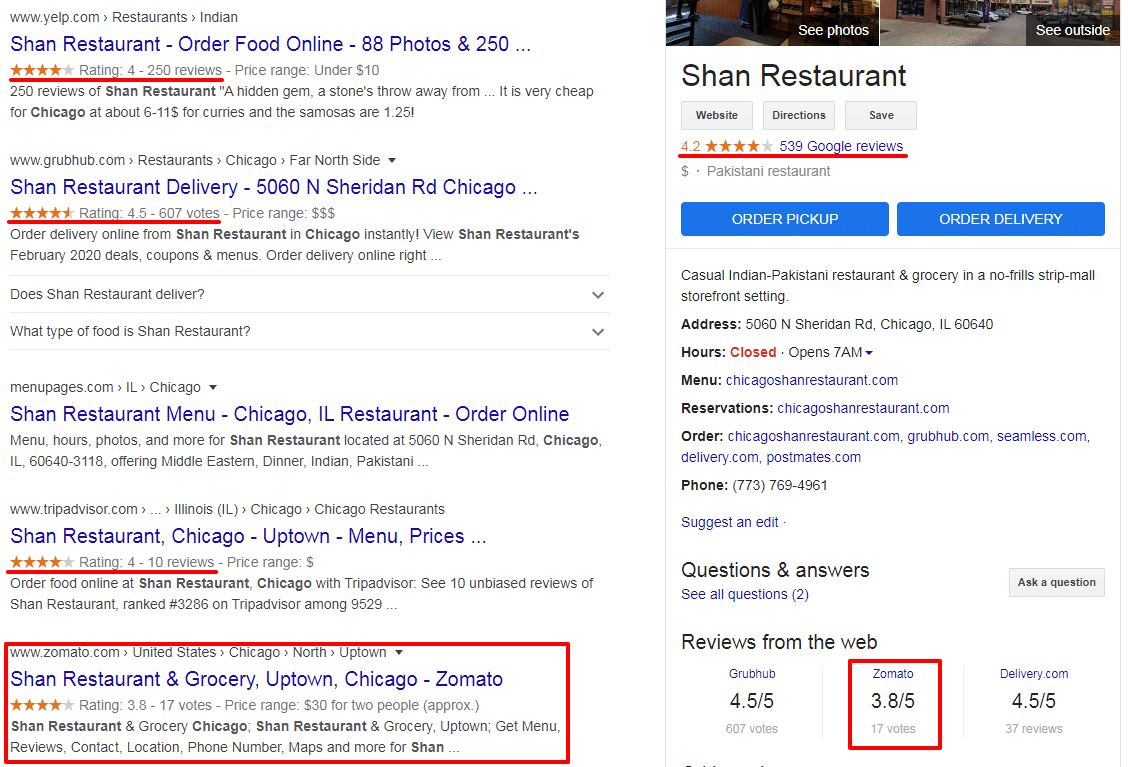
Used appropriately, Zomato gives restaurants a powerful presence in Google. It’s a fantastic way to win the local search game. Let’s take a look at The Purple Pig, a casual dining restaurant in Chicago, to see how they optimize their profile.
First, they have 968 votes “reviews” and an incredible 4.9/5 rating!
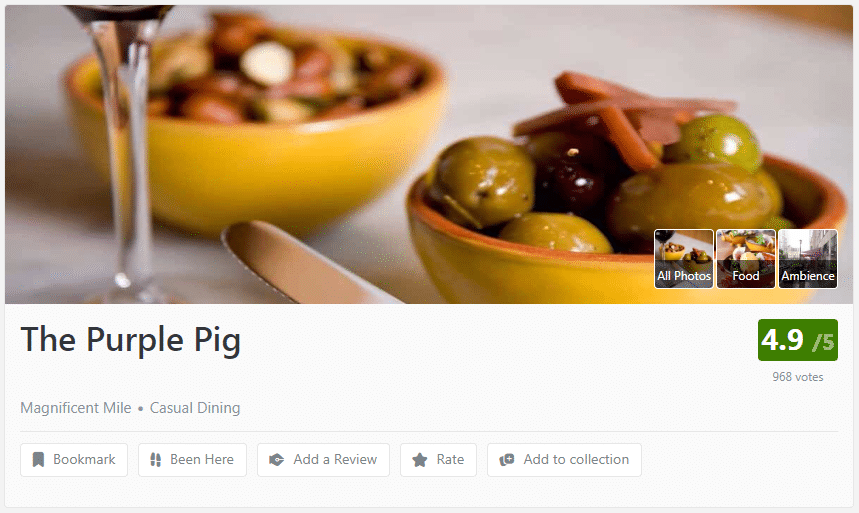
Second, they’ve added general business info and menu details. They even added information on their Chefs!
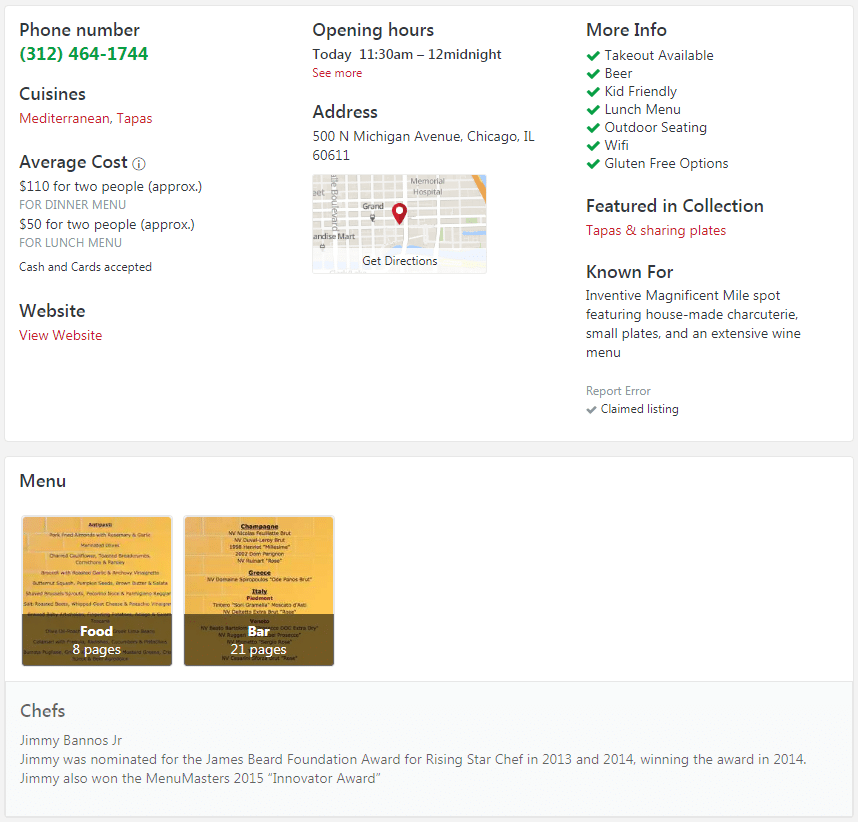
They’ve added photos of their establishment (and so have their customers).

They’ve also received a whopping 968 reviews from customers!
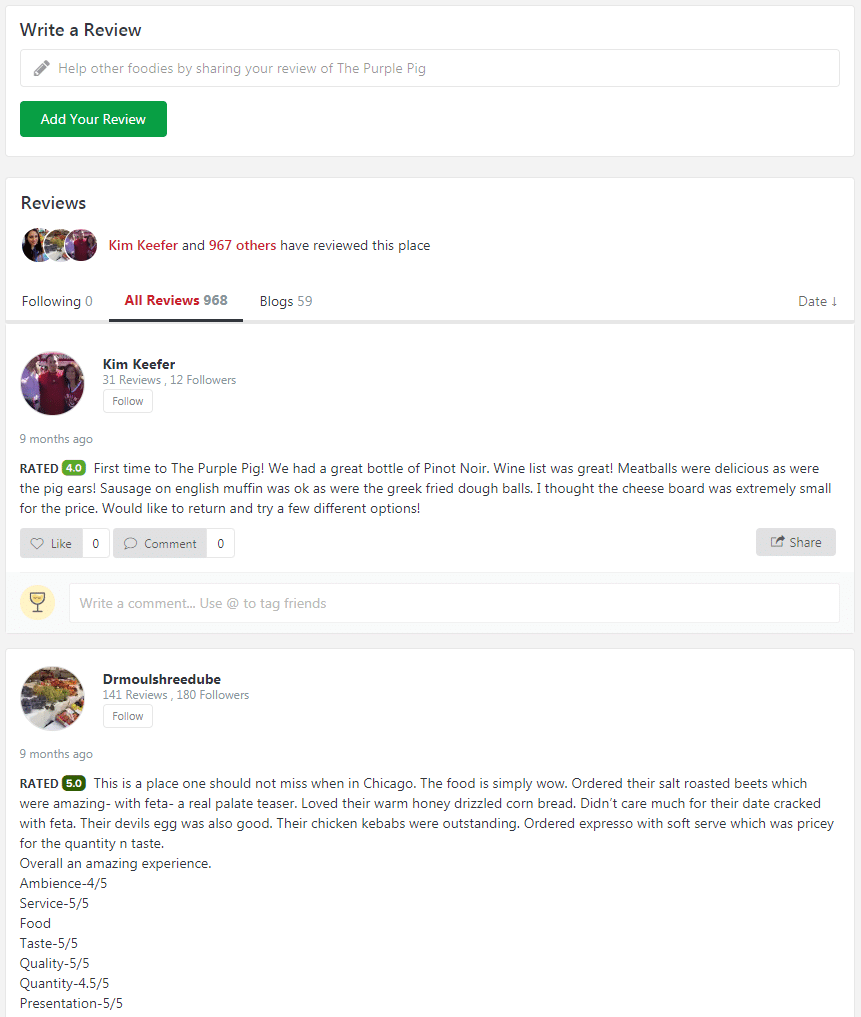
It doesn’t take much to create a strong Zomato profile. It’s just consistent effort — steady progress as you work to build a strong review portfolio. The research on this is pretty detailed. Add a star to your overall rating and you receive a 5 to 9 percent increase in revenues.
Requesting, tracking, and responding to reviews on Zomato
Get the Reputation You Deserve with Grade.us
Here’s the bad news.
Zomato has policies that are similar to Yelp. Here’s a detailed excerpt from their policies page.
“Guidelines for Restaurants
Zomato is a great way for restaurants to reach out to a vast foodie community. A few things you should keep in mind:
Keep your listing updated: While our team makes every effort to keep information on Zomato up-to-date, we appreciate you letting us know when an update is required. If your timings change and your listing is not updated, customers arriving late won’t be too happy with you (or Zomato).
Don’t solicit reviews: The best way to get reviews is to delight customers with your food and service. Selective solicitation is a strict NO, and offering any type of compensation or kick-back for reviews is unfair, so you definitely want to keep away from that, too.
Don’t ever offer freebies, discounts, or payment in exchange for reviews
Don’t offer incentives for users to remove reviews
Don’t ask your staff to compete with each other to collect reviews
Don’t work with companies or third-party vendors/PR agencies offering to ‘fix your reviews/ratings’
While conducting foodie meetups is allowed, reviews which come in lieu of these official gatherings must carry a clear disclaimer which will help the others identify that the review is based on an invite. That being said, an invite certainly does not mean that the user needs to post a positive review
The businesses that do best on Zomato are the ones that provide a great customer experience to everyone who walks in the door without any expectation or encouragement that they write a positive review
If we do come across any evidence (direct/indirect) of you indulging in solicitation, we will activate a disclaimer on your restaurant’s page, informing the Zomato community that your reviews are suspicious.
Respond to criticism positively: Take two deep breaths when you get a negative review. Three, if required. This happens to all restaurants that have customers. These customers are always right, even when they are wrong. Take the unflattering reviews as constructive feedback and use it as an opportunity to fix things. Whether you agree with the feedback or not, take the criticism in good stride. You can reply with a management response to show you care, but please don’t use this as a platform to hit back or offer the customer an incentive to edit their review. Your response can’t be edited after posting, so choose your words well.
Be accountable: Zomato will not moderate any questionable activities about your restaurant posted in reviews. Zomato may also not moderate or delete any reviews where any third party service provider is involved. Such a review may be retained if it falls within our guidelines. This business requires thick skin – stating the perceived attitude of owners or employees and reporting of individual actions are not considered personal attacks.
Don’t entertain: Fulfilling the demands of customers who ask for benefits at the threat of bad reviews or ratings, sends a message that this behavior is tolerated. Similarly, inviting users who have reviewed and given a low rating back to the restaurant for a complimentary meal, invites false negative reviews. These issues affect the entire community and require everyone’s participation to curb their prevalence. Please report users who engage in such activities to [email protected].
In a concerted effort to maintain the neutrality of content on Zomato, restaurant owners, employees, and any affiliates with business interests are no longer permitted to write reviews on Zomato. We understand that being in the restaurant industry, you are truly passionate about food, and would love to share your experiences. But when you’re unavoidably invested in your business, it becomes hard to leave emotions (and bias) at the door. This is a step towards maintaining neutrality – and quality – of the content on Zomato.“
Well, that sucks.
You’re not allowed to request reviews on their platform. The unethical or morally questionable portions make complete sense, but simply requesting reviews?
It’s not allowed.
The good news? You’re allowed to respond to reviews from individual customers, but you’re not allowed to write reviews for any other business on Zomato (which kinda sorta makes sense).
So how do you get reviews?
The same way you get reviews from Yelp users. You let customers know you’re on Zomato. Head over to their widgets page, and you can download buttons, badges, widgets and stickers.
Your Zomato point-of-contact
You can contact someone from Zomato using the following channels.
They haven’t listed a U.S. number at this point, so these are the only channels at this point.
What about goal tracking?
Goal tracking via Zomato
The Zomato for Business app allows restaurateurs to manage their profile via the app. You’ll need to claim your listing before you can use the Zomato for Business app. You’ll need to use the same credentials as your listing. Once you’ve done that, you can manage your restaurant using the app once you’ve completed the above steps.
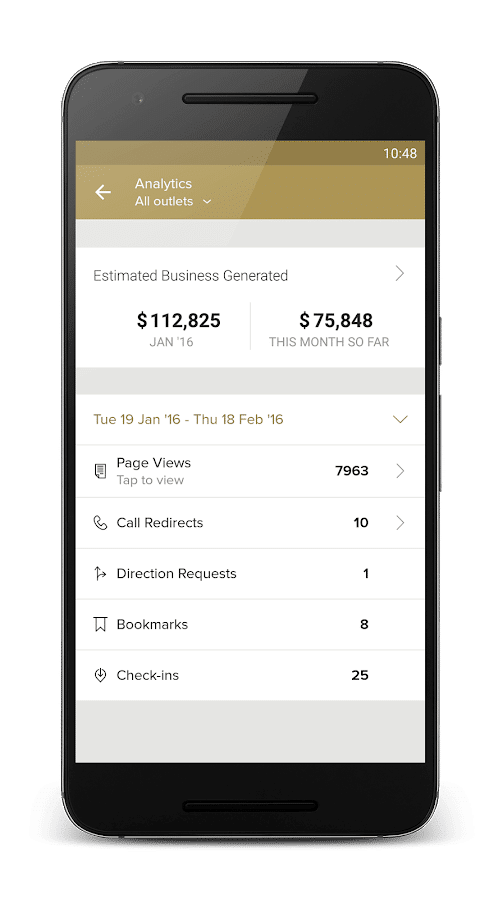
What can you do with the app?
- Answer Reviews: Get real-time notifications of new check-ins, photos and reviews, and easily answer Zomato reviews.
- Manage your Online Presence: Update your listing's information on the go.
- Analytics: Feel the pulse of your business: page views, generated revenue, and more.
- Promos and deals: Promos are a great way to promote your business to existing and potential customers on Zomato.
- Special menus: Serving something new every day? Planning a seasonal menu? Upload your special menu directly from the app.
- Events: Promote events that you are hosting in your establishment, from music performances to food festivals where you are participating.
Using the Zomato for Business app, you can maintain and optimize your profile. That’s perfect if you decide to advertise your restaurant on Zomato.
Advertising on Zomato
It’s kind of like the early days of Facebook ads. In the beginning, you could drive a massive amount of traffic on the cheap. You signed up for a Facebook ads account, set your max cost-per-click, changed a few details, and away you go!
Prices shot up once Facebook ads became a mainstream traffic source.
You’re in a similar position with Zomato. Their platform is well established in 21 other countries. They’re one of the largest food aggregators in the world. They’re growing rapidly but they’re not a well-established platform in North America, not yet.
But they will be.
Visit Zomato.com/business/advertise, and you’ll receive the standard details about their advertising programs:
- Guaranteed customer growth: Increase visits to your page, which will drive more footfall and revenue for your restaurant.
- Target the right audience: Get showcased to customers searching for what you have to offer, at the most relevant time and location.
- Track performance: Get access to state-of-the-art analytics and follow your campaign performance.
- Pay for results: Take the guessing out of advertising and only pay for the customers brought to your page.
You won’t get a whole lot more than this, though. If you’d like additional information, you’ll need to reach out to Zomato directly for more details on their advertising programs. How do you drive restaurant foot traffic with Zomato reviews?
You create an infinite return.
This is the strategy most restaurants don’t know about. It’s also why so many of them struggle to capitalize on the traffic they receive from review platforms like Zomato, Yelp, or even Groupon.
Here’s how you do it.
1. You let customers know you’re on Zomato (without requesting a review).
2. You wow them by optimizing the QAAA parameters in your business.
3. Use retargeting to capture prospects who were (a.) referred by a review site and (b.) visited your profile/site. These customers are warmer and more motivated than cold walk-ins.
4. You use remarketing ads + irresistible offer #1 to attract these customers to your restaurant or hotel.
5. Wow them with exceptional service, creating a wonderful experience.
6. At the end of their visit, you offer irresistible offer #2 to bring them back to your business.
7. Wow them again.
8. At the end of that visit, you follow up with irresistible offer #3.
9. Wow them again.
10. At the end of that visit, you hit them with irresistible offer #4 to thank them for their loyalty.
If they’ve made through each of these steps, they’re probably loyal customers who will continue to return to your restaurant regularly. Here’s a step-by-step example you can use to build your own marketing funnel.
This requires planning.
You’ll need to ensure that your pricing, systems, procedures, and business model can support this funnel. Fees from your regular customers should be more than enough to support this funnel. You’ll also need a firm understanding of volume. How many customers can your business support in a month or quarter?
Plan things out ahead of time.
This is how you increase orders and footfalls to your restaurant.
A strong review portfolio is the foundation
Restaurant traffic is falling.
Focus on the right parameters, and you’ll have what you need to attract more customers consistently. Most of your competitors are asleep at the wheel. They don’t see Zomato for the opportunity it is.
But you do.
Zomato is available in 24 countries, 10,000 cities, and 10+ languages. They’re popular for a reason but they’re new to our neck of the woods. Low advertising costs and 8x advertising returns mean it’s a viable platform for the restaurateurs who are paying attention.
If you’ve made it this far, you’re in the minority.
Take advantage of their platform now, and you’ll find you’re way ahead of your competitors. With consistent effort and a little bit of know-how, you’ll have what you need to drive 8x more foot traffic to your restaurant, no

